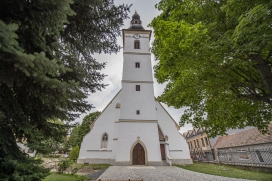Church of the Ascension of Mary
It was built at the beginning of the 14th century, probably on the site of an earlier 13th-century Romanesque church or chapel. Originally, there was no tower. The church’s patrons were the Counts of Szentgyörgyi and Bazini, as also shown by their coats of arms on the vaulting. The church’s vaulting was only built in the 15th century, in late Gothic style, following the example of St Vitus Cathedral in Prague. The most valuable element of its furnishings is the early Renaissance pulpit dating from 1523. Its baptismal font, carved from red marble and dated to Count György Bazini in 1426, his red marble epitaph and István Illésházy’s burial chapel are also worthy of attention. The church came into the possession of the Capuchins in 1674. It ended up in the hands of the Lutherans at the time of the Rákóczi uprising in the early 18th century. The high altar is the work of Stefan Steinmassler, who mastered his craft in the Bratislava workshop of Ludwig Gode, the acolyte of Georg Rafael Donner, the most famous transalpine sculptor of the age. The altarpiece depicting the Ascension of the Virgin Mary was created in 1789. In 1863, the Slovak master organ builder, Martin Šaško, made a new instrument for the church.




